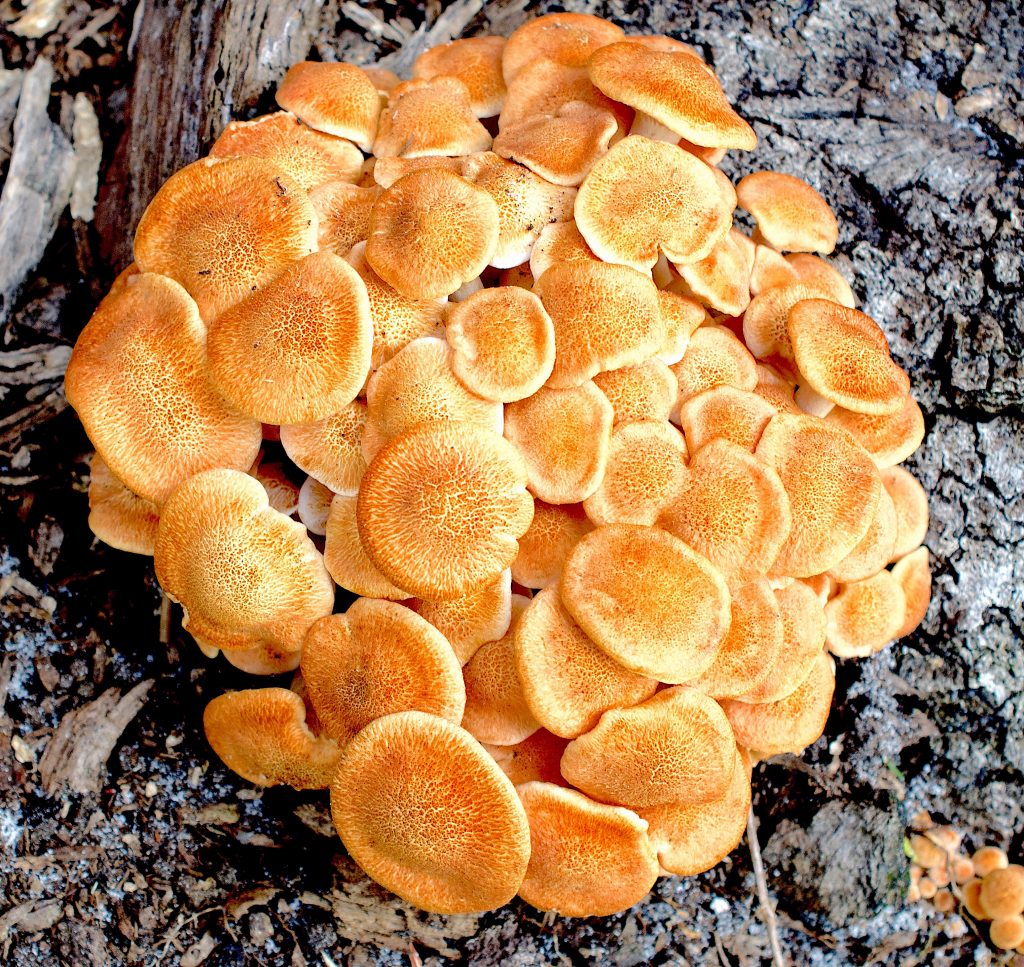
Ringless Honey Mushroom, Armillaria tabescens, Photo by Green Deane
Do not eat any mushroom without checking in person with a local, live, mushroom collector.
The first time I thought I saw the Ringless Honey Mushroom was about a decade ago in November on my neighbor’s lawn. The only problem was this species of mushroom grows on wood such as stumps or on decomposing roots (not mulch.) I had lived in the neighborhood 13 years and didn’t remember a tree on the lawn … though maybe there was a stump there when I first moved in…
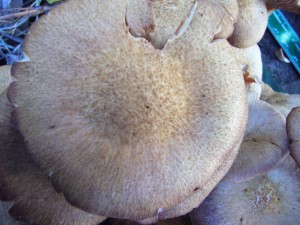
Notice a slight raise and more dark hairs in the middle of the cap. The cap’s flesh is also white (see inside crack) to help you distinguish it from the toxic orange-flesh Jack-O-Lantern. Photo by Green Deane
Next time I thought I saw it was 200 miles away in West Palm Beach growing on an Eastern Cedar stump, or Southern Cedar … much the same thing (Junipers.) Ringless Honey Mushrooms usually don’t like conifers (its the pitch I imagine. I’ve also noticed them growing on Camphor stumps — pass — and on banyan roots… maybe worth trying as that is the fig family.) The third time, however, was a charm, about a mile from my house growing on oak stumps in an area that had been cleared a couple of years earlier. It was a mushroom mine, so to speak. When I later took a Mushroom Certification class in late August in North Carolina they were everywhere. It gets cooler there sooner. Locally Ringless Honey Mushrooms like October through December with November being the heaviest month.
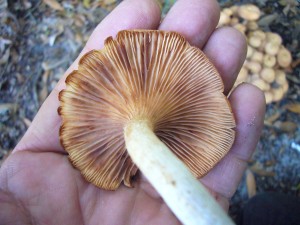
Gills are widely spaced, touch but don’t run far down the stem, and stain or turn brown or brownish pink when bruised or aged. Photo by Green Deane
The Ringless Honey Mushroom, Armillaria tabescens, is a southern stand-in of a very common mushroom in North America and Europe, Armillaria mellea. which is also edible. The A. mellea, however, has a ring around the stem — an annulus — as almost all Armillaria do. The Ringless Honey Mushroom does not have a ring and there is also one ringless species in Europe, the A. ectypa. It’s rare and classified as endangered in some areas. I note A. ectypa only grows in acidic marshes and is listed as edible and non-edible…. not good form to list an endangered species as edible. A. mellea is an infrequent Florida mushroom in the spring. Though looking similar it has an annulus and the cap is tacky.
As mushrooms go the Ringless Honey Mushroom is one of the easier to identify. The mushroom grows on wood, preferably oak. But has also be found growing on Buckeyes, Hemlock, Hollies, Junipers, Sweetgums, Plums, Apples, Perseas, Maples, Pines, Ash, Alders, Almonds and Walnuts. Ringless Honey Mushrooms found growing on Hemlocks and Buckeyes are known to cause digestive upset. I would avoid those growing on plums, apples, almonds and hollies. Those trees can have some nasty chemicals in them including hydrocyanic acid. However a mycology professor specifically told me these mushrooms should not pick up any bad chemicals from such trees. Oak is the most common and safest bet. You will find it on stumps, exposed roots, at the base of trees, and growing on buried roots. This is particularly common where a dead tree has been removed so there appears to be no tree but the mushroom is still living on the buried dead root. This is why one can find them growing in lawns without any trees nearby. Incidentally, if the tree you find them on is living this species will in time kill it.
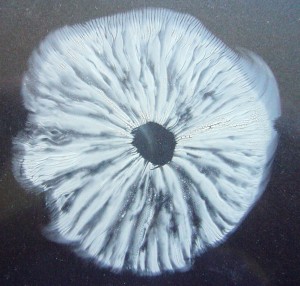
The spore print is white which helps separate it from the hallucinogenic Gymnopilus spectabilis (orange-brown spores) the deadly Galerina autumalis (brown spores) Pholiota species (brown spores) and Hypholoma fasciculare, “Sulphur Tufts” which are also cespitose and have purplish-brown spores. Photo by Green Deane
James Kimbrough in his book “Common Florida Mushrooms” says of the Ringless Honey Mushroom: “This is the most common late fall-early winter mushroom in Florida. It causes mushroom root-rot of numerous tree and shrub species, and is especially critical in the die back of oaks. It is seldom found in summer months, but appears in striking numbers as soon as late fall rains commence. It is a choice edible species, but because of its toughness, must be cooked longer than the average mushroom.” I would add one usually does not eat the stem (use them for flavoring.) The mushroom is also a good candidate for drying. I fry them them in coconut oil until they are about half the size they started and thoroughly cooked. Some people have to parboil them first then fry them to avoid digestive upset. And a few rare folks can’t eat them no matter how cooked. I think they’re tasty. Younger mushrooms are a bit more springy than middle-aged ones. I think the best age/size is when they are between the size of a quarter and a half dollar. Their texture lends themselves well to dishes that require long cooking.
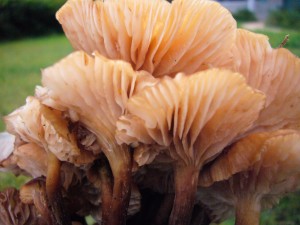
Gills are knife-thin, sometimes forked, stems are white or light yellow on top tapering downward to darker stems. Photo by Green Deane
As for the scientific names, Armillaria (ah-mill-LAIR-ree-ah) is Dead Latin for “little bracelet.” Tabescens (tay-BESS-sins) mean decomposing. One would like to think it is called “little bracelet” because it can embrace an entire small stump but no. It is because of a bracelet-like frill on the fruiting bodies. And I don’t know if tabescens refers to helping wood decompose or the brown-black pile of dried muck the mushroom becomes when reproduction is done. They are called “honey mushrooms” because their color is similar to honey. And it should be added that not all categorizers of mushroom like “Armillaria” for the genus and prefer “Desarmillaria.” The naming science is not settled.
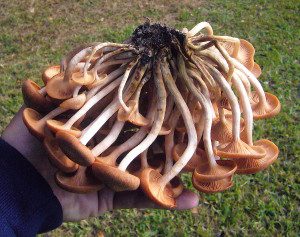
Ringless Honey Mushrooms are cespitos, growing in a cluster. Also note how light-colored the young stems are. Photo by Green Deane
Kimbrough describes Ringless Honey Mushroom this way: Pileus is 2.5-10 cm, convex to plane, sometimes sunken at the disc with uplifted margins; yellow-brown with flat to erect scales. The lamellae are decurrent, somewhat distant, staining pinkish brown with age. Stipes are 7.5 to 20 cm long, 0.5 1.5 cm wide, tapering towards the base; off-white to brownish in color, lacking an annulus. Spores are white in deposit, broadly ellipsoid, 6.0-10 x 5.0-7.0 um, not staining blue in iodine. Basidia are clavate, 30.0-35.0 x 7.0-10.0 um, with four sterigmata. Normally I would translate those technical terms into plain English but with mushroom you should also learn the argot. But to give you an idea: The cap is one to four inches across, shaped like an upside down bowl to flat across the top with the edge turned up…
David Arora author of Mushrooms Demystified, describes the related Armillaria mellea as an edible spring mushroom then adds Armillaria tabescens is the same except no ring (annulus) and a dry cap. He provides more details:
Cap: 3-15 cm broad or more, convex becoming plane or sometimes broadly umbonate or in age uplifted; surface viscid or dry, usually with scattered minute dark brown to blackish fibrillose scales or erect hairs, especially towards the center; color variable: yellow, yellow-brown, tawny, tan, pinkish brown, reddish-brown et cetra. Flesh thick and white when young, sometimes discolored in age; odor mild, taste usually latently bitter.
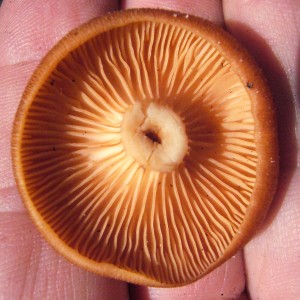
A young cap’s color is uniform without any brusing or aging towards brown-pink. Photo by Green Deane
Gills: Mushroom perfectionists can really rattle on about gill attachment, which are admittedly important. Start with the acronym F.A.D. meaning Free, Attached, Descending. Gills are one of those three but there are nuances. Do they touch with an upward swing or a square-on 90 degree connection? If they don’t attach the stem at all they are free. Ringless Honey Mushrooms are “attached” more specifically “adnate” meaning square on to slightly decurrent (running down the stem some) or sometimes notched — half adnate; Just remember they are attached and can run down the stem. The gills are white to yellowish or sordid flesh-color, often spotted darker in age. Stalk: 5-20 cm long, 0.5 3(5) cm thick, tough and fibrous with a stringy pith inside; usually tapered towards the bottom if growing in large clusters, or enlarged below if unclustered and on the ground; dry, whitish (above the ring in the A. mellea) soon yellow to reddish brown below and often cottony-scaly when very young. Spore print white 6-10 x -6 microns, elliptical, smooth, not amyloid.
Habitat: In small or massive clusters on stumps, logs, and living trees, or scattered to gregarious (occasionally solitary) on ground — but growing from roots or buried wood; common on a wide variety of trees and shrubs… on oaks trees the mycelium (mushroom roots) can frequently be seen as a whitish fan like growth between the bark and wood.
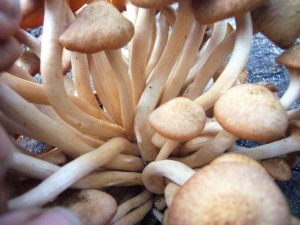
Whether young or middle aged select only firm caps for cooking. Stems are tough and fiberous. Photo by Green Deane
Arora says (of the A. mellea which he also says describes the A. tabescens) is eminently edible. Use only firm caps and discard though stalks (which are used for stock.) It is an abundant food source, crunchy in texture, and a very passable substitute for the shiitake in stir-fry dishes. Arora recommends because of its various forms beginner should pick only those growing on wood.
There are three or four similar-looking mushrooms which are toxic. The Galerina autumnalis has a ring, is smaller, and has brown spores. The Pholiota species also have brown spores. Gymnopilus have rusty-orange spores. The Sulphur Tuft, Hypholoma fasciculare, which likes to grow on wood, has purple-brown spores. That leaves Jack-O-Lanterns, Omphalotus.
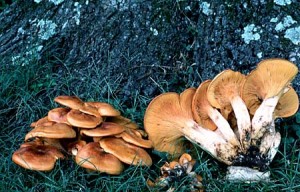
Jack-O-Lantern mushrooms, above, look similar but the cap’s inner flesh is orange or yellow, not white like the Ringless Honey Mushroom. The Jack-O-Lantern can cause severe gastric distress.
“Jacks” are similar but in age can become vase shaped. More importantly their color is shades of orange or reddish-orange, occasionally yellow orange or one species olive orange. The cap is smooth, the Ringed Honey Mushroom has small black hairs. Also the gills run down the stem strongly on the Jach O Lanterns whereas in the Ringless Honey Mushroom the gills meet the stem or run down only a little. The flesh of the Jack-O-Lanterns is about the same color as the cap whereas the Honey Mushroom cap is tan/brown and the flesh is white. If you’re healthy Jacks won’t kill you but will cause severe gastrointestinal illness. Fresh Omphalotus gills can glow faintly in the dark. I’ve seen this several times. As the mushroom ages it loses the ability to glow so don’t rely on it. Some folks mistake Jacks for Golden Chanterelles but Chanterelles when cut are white inside (like the Honey Mushroom) and do not have true gills but rather ridges.
From the kitchen of James Kimbrough: Mushroom Meatloaf.
2 pounds of Armillaria mellea or A. tabescens
1 Large onion
2 Tablespoons butter
1/2 Cup of dry bread crumbs
2 Eggs, lightly beaten
1/4 Butter melted
1/2 Teaspoon salt
Dash of pepper
Saute half of the onion in two tablespoons of butter until golden brown. Save several large mushroom caps for garnish. Chop remaining mushrooms, including stems and remaining onions; mix with bread crumbs, salt, pepper, and remaining butter. Stir in eggs and sauteed onions. Press entire mixture in a well-greased loaf pan. Arrange mushrooms caps on top and press slightly. Bake for one hour at 350 F. Let stand several minutes; slice and serve with mushroom gravy.

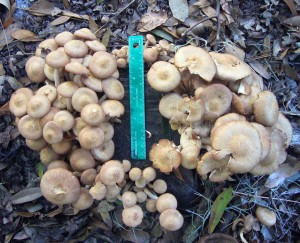
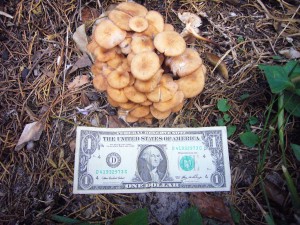
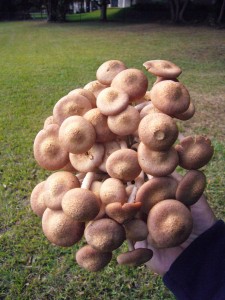
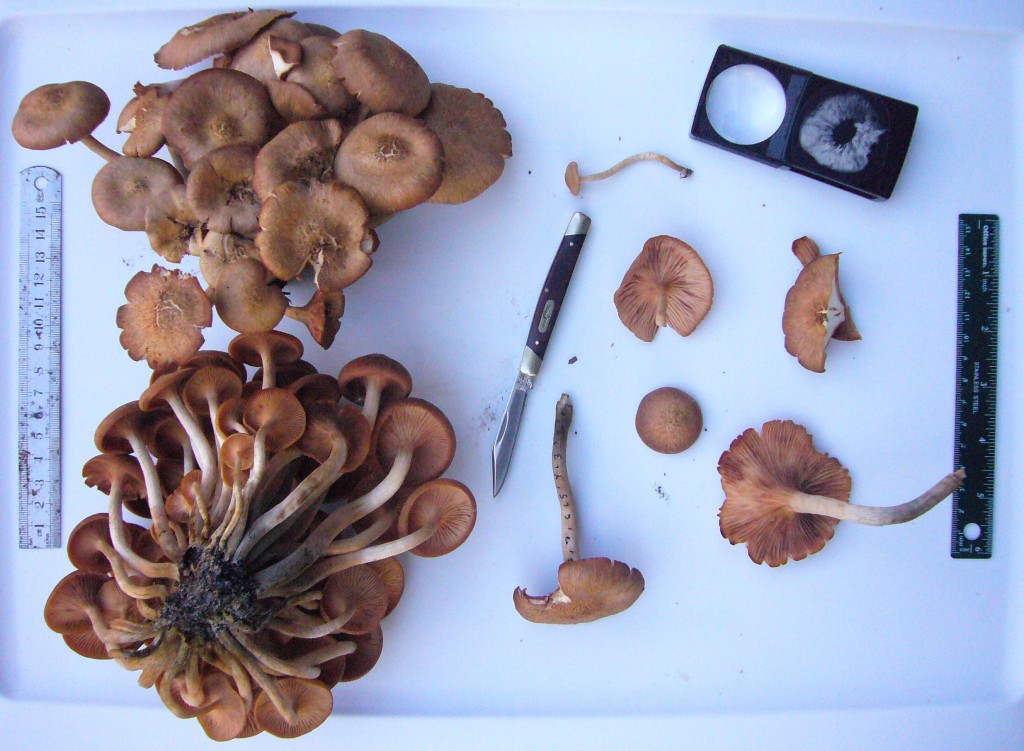

Thanks to this post I just found out that Armillaria luteobubalina, the awful fungus that kills off large tracts of trees in Australia and infests gardens is edible! If you can’t beat it…EAT it! 🙂
“Some writers say that mushrooms which grow on wood won’t kill you”. In Missouri, “Some writers” would either be very ill on a regular basis or dead.
To quote Missouri Department of Conservation, “Jack-o’-lanterns have knifelike gills and grow in the tight clusters on wood or buried wood, rather than on the ground.” (http://mdc4.mdc.mo.gov/tv/hints/mushrooms.pdf)
Once again proving your point – do not eat anything you do not positively know to be safe to eat. If an “expert” says it is and you question his authority or are otherwise suspect, have him harvest it, prepare it, eat it, all in front of you, and then come back in 24 hours to see if he is alive and well before you eat it. And, do NOT listen to wives tales or believe everything you see written, especially on the internet.
If it is a mushroom and is growing on wood, it CAN kill you.
Thanks for providing me a safe and enjoyable foraging experience via your site and your youtube videos.
Mike
Good point. Jacks can make you quite ill but usually are not fatal… you just wish they were.
wood-growing mushrooms definitely can kill you. Wood-growing shelf-mushrooms (no stem) that have pores instead of gills (repeat, no gills) are the sort of thing that’s almost certainly not going to kill you and might cure you of something, but you have to include those other parts to that rule. On the other hand, the chicken of the woods (Laetiporus sulphureus) is one of those, which is usually considered a good edible, but some people react to it with gastric distress. Galerina autunmalis grows on wood and is deadly. It’s a fairly standard-looking brown mushroom with a cap and gills. It has killed people in the west who mistook it for Psilocybe cyanescens, a halucinogenic mushroom that grows on wood. I’m sure there are others I could find, but my point has been made. Mushrooms usually either grow on wood (can be buried wood, like a root) or in the ground (or in mycorrhizal association with roots, which is basically in the ground too). This is usually a good identifying feature, but not absolute. Some species do funny things. Some wood-eating mushrooms will pop up from the ground near some wood they’re eating, but I haven’t heard of them going the other way.
hey thanks for the info. had a question about something completely different however didnt know where to post it?
CAN YOU eat muskovey duck and eggs?
Absolutely. In fact they are the most consumed duck on the planet. Personally I like duck eggs. More yolk, a tad rubbery.
Absolutely. I have had the eggs and they are very rich, having a large yolk. As for eating these ducks, you can but I can’t imagine doing it as they are gentle, quiet, very friendly, and trusting. To me, it would be like eating a household pet.
What do you use to make your spore print?
A clear plastic sheet. They are sold in office supply stores for making clear overhead projections. You removed the stem and put the mushroom gills down on the sheet. Wait a few hours.
Great article, Deane! Thank you. I think I have seen these growing on some of the stumps around my golf course, although what I have seen has been pretty dark and they dont have very long stems. They look like the first picture in the article. There is also a white mushroom that grows everywhere around the course. I have never been able to identify it. I fruits into a pretty large cap. Sometimes 6″ ore more. They don’t grow in clusters or anything and prefer plain soil. I wish I knew if they were edible or not. I could eat so well. lol
Of course make sure you are right. Point two: Never eat a white mushroom with white gills. Never.
Thanks for the tip! They’re not fruiting right now, but when they do I’ll take a closer look at them and try and get a spore print.
That’s a good beginner tip, but there are some good white/white mushrooms, like Leucoagaricus leucothites.
who has the most complete book omushrooms currently available
David Arora… but there are some good regional ones as well.
Not sure if it would qualify as ‘most complete’, but Paul Stammets, PhD has written a great book on mushrooms, ‘Mycellium Running’. His website, (from memory http://www.fungiperfecti.com), has a wealth of information. Some of his lectures and shorter talks appear on YouTube.
I woul like to dry the Tablescens is there any special precautions or procedure I should know? Thanks for the article btw it is awesome and one of the best I found.
Some folk separate the caps and stems first, and most people cook them twice using them the second time.
What a great post! Thorough, great illustrative pics, and very readable.
Found me a dead standing oak , I also found many many many of these all around it. The clusters were only 5-6 each and many singles or small clusters, is late May. We have had several days of heavy rain. I’m waiting on a spore sample to be positive before dinner. Thinking about adding them to dandelion greens, garlic, onion, and bacon.
I have tons of these things growing under 2 Chinese Chestnut trees and a Silver Maple tree, I wish I had the guts to cook them up. They look scrumptious!
We found some yesterday in S. NH And went to several sites that identify and also checked books and felt certain they were Honey mushrooms. In a different area, a trail, we found dozens of a similar mushroom but no ring. I did a spore print over night and nothing showed up! I guess I’ll just put them back in the woods since I’m just learning. they are definetly not Jack o Lanterns but I’d still like to see them glow!
Thanks for your information. I have a lot of this growing in my yard. At first I didn’t know about honey mushroom but when I saw this bunch of golden buttons growing in my yard where the tree stump was and all over rotten roots, I start searching about edible mushroom. I’m no expert about mushroom but growing up in the Philippines as a little kid I used to hunt mushrooms just one kind of mushroom on spring time. So I kind of knew how they smell like. I smell this mushroom and it smells similar to the one I’m used to. I cooked some and eat it. I told my sister in Germany about the mushroom and she’s worried that I might get poison. I said I’m still alive. And she told me what they do in Germany to boil water, chop some union in it. Put the mushroom if the union turns black that means the mushroom is poisonous. I did that the next day the union stays white. Yes, I think the mushroom killed our tree. Three of them died since we move to this house. Now mushroom all over where the tree used to be. I got my revenge eating them.
Wive’s tales are completely unreliable regarding mushroom edibility.
Will Armillaria Tabescens kill my grape vines? I found a bunch of these mushrooms clustered in the vineyard around an old stump of a tree we cut down several years ago. I’m wondering will these mushrooms affect my vines? Thanks!
Good question, but I think they prefer trees not vines.
i have just found quite a few. in fact so much i don’t know what to do with it. i don’t eat mushrooms i cant identify 100%. i was wondering if you wanted them i could dry them and sent it to you or freeze them with dry ice and send them to you as well. i live in east TN and the date is 10/25 if you want them get back to me soon!!! don’t know how long they will last. plus is there any defining factors from the look-a-likes? if so what are they?
Most people par-boil then freeze them.
do you want them? i can send them to you.
No, but thanks. There are plenty here.
Hi Green Deane. I have these mushrooms popping up all over the yard they are in clusters. I live in North Carolina ( Moore County ) if that matters.they are orange ish to yellow in color. I’m trying to identify them and determine if they are edible.they look very close to the honey mushrooms. can you be of assistance? I’m not sure how to send you an image?
You can post them on the facebook page of Southeastern US Mushroom identification. Have you done a spore print?
These look like I know as Shelf mushrooms or elephant ears in the Ozarks of Missouri. Are they the same kind, I wander??
I found a similar cluster of mushrooms that grew off old tree stump. The cluster was approximately 1 foot wide. When it rots there are tons of maggots that eat the mushroom flesh. They look similar to these photos. Does this sound like this mushroom or something different. Is it toxic since the maggots are eating it?
Most mushrooms, toxic and edible, are attacked by insects. Insects do not have a liver so they can eat a lot of stuff that would kill us. Also whether animals et cetera can eat something is irrelevant to whether we can. Many mushrooms grow on wood. One would have to see a picture. If you live in Florid or the southeast I can recommend two facebook pages that identify mushrooms.
I live in Florida and would like the names of the identification Facebook pages. I also have these little clusters growing freely in my yard or at the base of oak stumps. My yard is full of water oaks, I have 1 cedar, 2 pines, but it is mainly water oaks. But these grow everywhere on my lawn. Thanks in advance.
Florida Mushroom Identification Forum. Edible Mushroom Florida. Orlando Mushroom Group.
Thank you for the wonderfully written article! They’ve popped up everywhere here in Wichita Falls, Texas, within the past few days. I’ve been taking mushroom pictures in a 474 acre park, in the center of town, for the past couple of years. Most mushrooms are poisonous. I feel that even more than most from here are deadly; being that we are part of the transitional area for hill country, woodlands, grasslands, and desert. The very first time I went hunting for Agaricus campestris was in a field outlined with pecan & oak. I noticed, on the very edge of a campestris group, an unusually white mushroom that was taller than the rest. It was an Amanita bisporigera. So, until recently finding a cluster of oysters the size of my head, I haven’t even considered foraging anymore. Now, at least, I’m using the Audubon NA Mushroom Field Guide & Roger’s Mushroom app. Again, this article is very well written. It’s concise, straight to the point, has clear pictures with excellent captions, and it’s short. Most people are too impatient to do anything past a pictorial comparison. Such impatience could kill, or violently empty the guts of, anyone that misinforms themselves by means of ignorance. Good job! I’m bookmarking this site.
Very well explained, thank you. Also so glad you added the recipe, that always helps.
We had a gazillion of these in our yard this year. I didn’t try to eat them because I was not sure about their safety. What I did find out is if they are left to rot the sink is like rotting meat and covered with tiny maggots underneath the cap. I learned the hard way when I found large colonies rotting under our deck stairs.
I’m a biologist and micophage from way back. Compared to their northern cousins, the ringless honey mushrooms in Jacksonville proper seem much less married to the base of trees and stumps, i.e. they frequently grow mid-lawn. Perhaps this means they are emerging from a shallow root (as jack-o-lanterns sometimes do), but my observations don’t bear that out. I’d also caution against seeing these as tree-killers. In a healthy forest only some trees are affected by shoestring fungus (another name for Armellaria), which travels through the forest in a hopscotch fashion. Like many diseases and decomposers, native “wood destroying” fungi typically attack only those trees which are already in decline due to competition or site conditions. In that sense they are only hastening a process of death and rebirth that was already underway. Weakened trees become more susceptible to attack in a manner analogous to humans with compromised health or immune systems. All part of the cycle.
Hello, just came across your article looking to verify whether I have found honeys. I would just like to tell you that this is the most comprehensive ID guide I have found for them, especially with the inclusion of look alike and how they differ. Thank you for sharing your knowledge.
I found this mushroom growing on the base of a half-dead fruitless mulberry tree in De Leon, TX (took pics 10-10-20). Since this blog didn’t activate image uploading, you can see the pics on my Facebook page.
https://www.facebook.com/shane.russell.370/posts/3316467255128002
Hi there, just wondering why it says “Gymnopilus” at the top of this post?
I land on your pages often when looking up stuff, I really enjoy it, thanks for your effort.
That mushroom is mentioned in a cutline advocating taking spore prints.
I have loads of these “clumps” of mushrooms in our mulch. The only thing is that the stem is flat & dark (red or brown) & the caps are from 1/2″ to about 1 1/2″ across. Question~do the ringless HONEY’S have this type of stem? I can send a pic if you need to see them~they smell like the HONEY’S, but there are just so many we have, I wouldn’t believe our luck. PS ~ spore print is white~
Usually Honeys will not grow in mulch. They like roots or trees but not mulch. You might have some Gymopus or the like. They like mulch.
I was told that the stems on any Honey cap are inedible and piosous. Is this true or not? I have been only using the caps lol.
The older stems can be tough. Some folks use them for flavoring. They are not any more poisonous than the caps (which means some people cannot eat caps or stems: They get digestsive upset.)
For current naming, see: Desarmillaria caespitosa, a North American vicariant of D. tabescens. https://doi.org/10.1080/00275514.2021.1890969
In North florida, I’ve been noticing these coming up in very very large bunches at the base of and on the trunk of a very old magnolia tree the last couple of years which is rapidly deteriorating but still very much alive. I don’t have the nerve to try to cook these but it has been fascinating to see clusters of hundreds of them